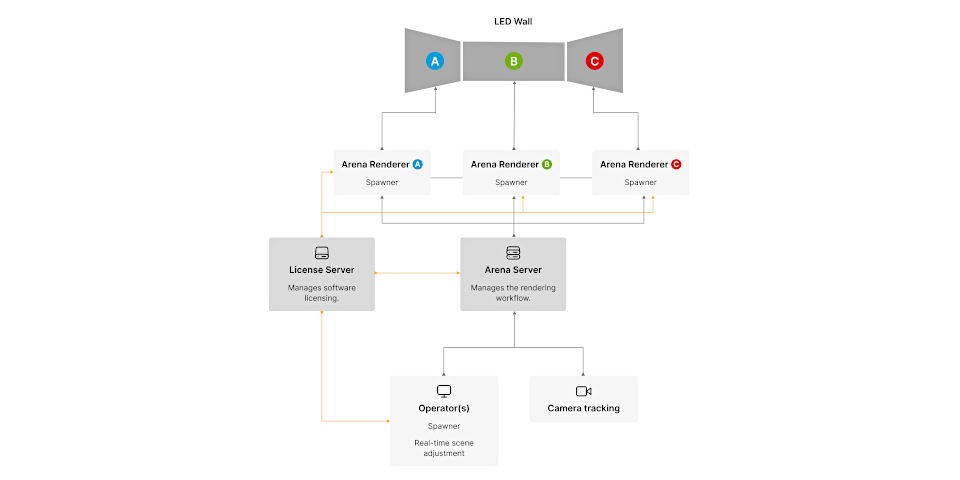
Chaos launches Chaos Arena
www.cgchannel.com
html PUBLIC "-//W3C//DTD HTML 4.0 Transitional//EN" "http://www.w3.org/TR/REC-html40/loose.dtd"Chaos has released Chaos Arena, its real-time solution for in-camera visual effects (ICVFX) in virtual production.The technology is intended to enable studios using Chaoss V-Ray renderer for offline rendering to display the same assets on LED walls with full ray tracing, without any preprocessing.Chaos pitches it as a faster, simple alternative to game engines for virtual production.Re-use assets created for offline rendering in V-Ray in real time on a LED wallUnveiled last year, and originally codenamed Project Arena, Chaos Arena is intended to render assets created for V-Ray pipelines in real time for display on a LED wall, creating a virtual backdrop for previs or in-camera VFX.It enables multiple operators to make changes to a 3D scene in response to a director or DoP, with Arena co-ordinating the edits, and synchronizing rendering to the LED wall.It uses the same core tech as Chaos Vantage, Chaoss real-time ray tracing renderer for exploring large V-Ray scenes, but is designed for distributed rendering on curved screens.Chaos describes it as the first-ever path-tracing solution for virtual shoots.Uses a server/spawner architecture with multiple operator machines and render nodesArena uses a server/spawner architecture, with a central server application connected to multiple spawner instances.The spawner is used both for operator machines, which feed changes made to a 3D scene to the server; and for rendering, with the server feeding instructions to the render instances.Separate spawners control output to different regions of the LED wall.For real-time camera tracking, Arena is compatible with network client protocols for Vicon and OptiTrack mocap systems, stYpe and EZTrack camera tracking systems, and the FreeD protocol.A simpler, more streamlined alternative to workflows based around Unreal Engine?As with Chaos Vantage itself, Project Arena is Chaoss attempt to break into a part of the industry in which Unreal Engine has done a lot of the early running.The game engine is widely used in virtual production, for which it could initially be used for free, although Epic Games did eventually begin charging larger studios last year.Chaoss pitch for Project Arena is similar to that for Vantage: that users will be able to use their existing V-Ray assets in it, without the kind of time-consuming conversion process required to prepare offline assets for rendering in a game engine.According to Chaos, Arena eliminate[s] the need for scene stripping, asset conversion, or baking, making it possible to move V-Ray animations to LED walls in around 10 minutes.The workflow makes it possible for studios to use the same assets in pre- and post-production with no do-overs or drops in quality.Current restrictions and performance limitationsAlthough Chaos Arena works with standard .vrscene files exported from V-Ray, it doesnt support every feature of the .vrscene format, or those of V-Rays host applications.For example, Arena does not support all of the advanced properties of Maya lights or cameras, or all of the properties of the V-Ray Material in files exported from V-Ray for Maya. You can see a list of .vrscene features supported for each of the V-Ray host applications compatible with Arena in the online documentation.As well as Maya, the documentation currently covers V-Ray for 3ds Max, Cinema 4D, Revit, Rhino and SketchUp.There are also a number of known limitations when using Arena in production, including a limit of 10 material layers in blend materials, a single dome light and environment fog per scene, and a maximum texture resolution of 16,384 x 16,384px.Operations currently supported in live editing mode include moving, rotating, scaling and hiding/unhiding objects, and adjusting lights, environment properties, scene states, and rendering and post-processing settings.Price and system requirementsChaos Arena is compatible with Windows 10+. It requires a DXR-capable GPU, although it doesnt currently support mixed-GPU-vendor setups: the system requirements specify a NVIDIA RTX GPU, rather than AMD or Intel processors.The software is priced on demand.Read an overview of Chaos Arena on Chaoss websiteRead more about Chaos Arenas capabilities in the online documentationHave your say on this story by following CG Channel on Facebook, Instagram and X (formerly Twitter). As well as being able to comment on stories, followers of our social media accounts can see videos we dont post on the site itself, including making-ofs for the latest VFX movies, animations, games cinematics and motion graphics projects.
0 Commentarios
·0 Acciones
·67 Views


